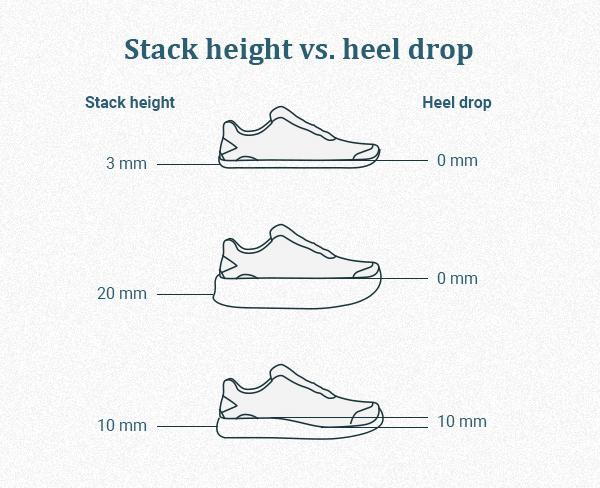
often get asked by patients and runners about footwear and selecting proper shoes. However, it can be frustrating at times to select proper footwear due to the complex features and attributes of a running shoe. Furthermore, shoe brands change the names, styles and features of shoes consistently which makes it hard to know which shoes to buy. In order to select better running shoes it is best to start with learning about heel drop and stack height.
What is heel drop?
Heel drop is defined as the height difference between a shoe’s sole at the heel versus the toe. A shoe’s heel drop ranges from 0 – 16mm.
0 – 4mm low heel drop
4 – 10mm moderate heel drop
10+ mm high heel drop
What is stack height?
Stack height is defined by the height of the material underneath a person’s foot in their running shoes. A shoe’s stack height ranges from 3 – 50mm and higher values are analogous with increased absorption (cushion) in the shoe.
3 – 8mm low stack height, barefoot shoes
3 -13mm minimal stack height, minimal shoes
9 – 29mm moderate stack height, regular running shoes
30 – 50mm high stack height, maximum cushion shoes
What is the difference between heel drop and stack height?
Therefore the difference between heel drop and stack height is that heel drop is the difference in the height of the shoe’s outsole at the heel versus the forefoot, whereas stack height is the height of the shoe’s material underneath the foot.

Photos courtesy of Runrepeat.com
Which runners benefit from heel drop and stack height?
It is important to note that the research supports a moderate heel drop and stack height shoe for almost all running styles and runners. It is very rare that shoes with minimal heel drop or stack height are recommended. However, there are several guidelines to follow when selecting shoes. If you run with a heel strike or rearfoot strike you will benefit from a moderate to moderately high heel drop and stack height shoe. This will help to cushion the impact from the ground while you run. Conversely, if you are a forefoot runner you will benefit from a moderately low to moderate heel drop and stack height shoe. However, use caution while considering shoes such as Hoka’s with excessive stack height or Altra’s which provide zero heel drop as impact forces directly increase with these shoes. Lastly, it is important to correlate your running form with the shoe you select. If you would like to learn more about your running form, consider a RUNATOMY session for a custom video running analysis and footwear recommendations for your specific running style. Check out runatomy.com for more information.
Run better, faster, safer!
Justin Jellin, DPT
Program Director RUNATOMY
Doctor of Physical Therapy
References:
Jewell C, Boyer KA, Hamill J. Do footfall patterns in forefoot runners change over an exhaustive run?. J Sports Sci. 2017;35(1):74-80. doi:10.1080/02640414.2016.1156726
Kulmala JP, Kosonen J, Nurminen J, Avela J. Running in highly cushioned shoes increases leg stiffness and amplifies impact loading. Sci Rep. 2018;8(1):17496. Published 2018 Nov 30. doi:10.1038/s41598-018-35980-6
Malisoux L, Chambon N, Delattre N, Gueguen N, Urhausen A, Theisen D. Injury risk in runners using standard or motion control shoes: a randomised controlled trial with participant and assessor blinding. Br J Sports Med. 2016;50(8):481-487. doi:10.1136/bjsports-2015-095031
Malisoux L, Gette P, Backes A, Delattre N, Theisen D. Lower impact forces but greater burden for the musculoskeletal system in running shoes with greater cushioning stiffness [published online ahead of print, 2022 Jan 19]. Eur J Sport Sci. 2022;1-11. doi:10.1080/17461391.2021.2023655
Pollard CD, Ter Har JA, Hannigan JJ, Norcross MF. Influence of Maximal Running Shoes on Biomechanics Before and After a 5K Run. Orthop J Sports Med. 2018;6(6):2325967118775720. Published 2018 Jun 7. doi:10.1177/2325967118775720
https://runrepeat.com/guides/heel-to-toe-drop




